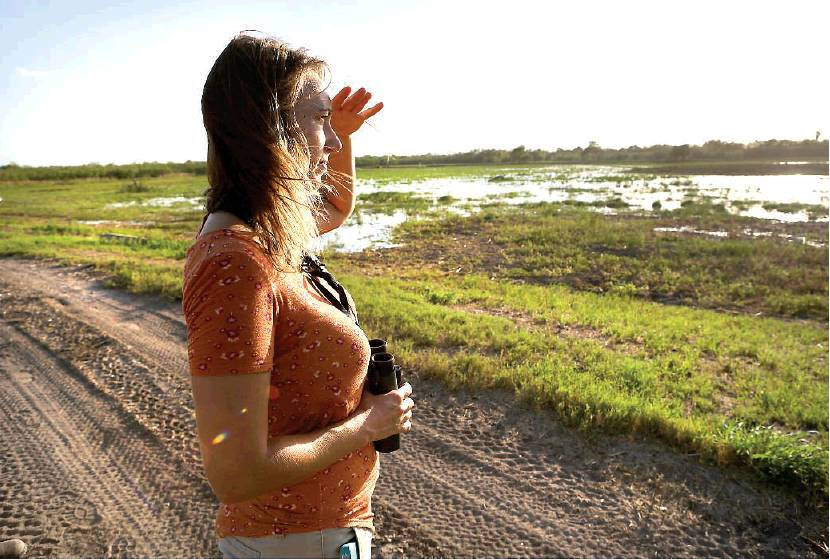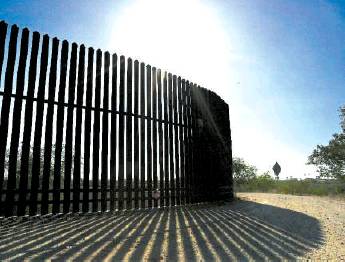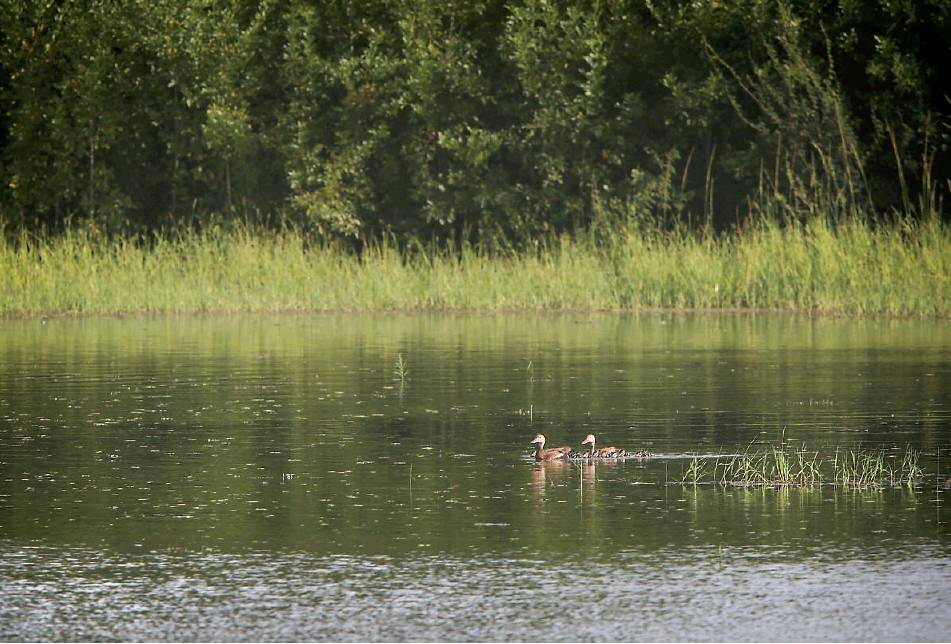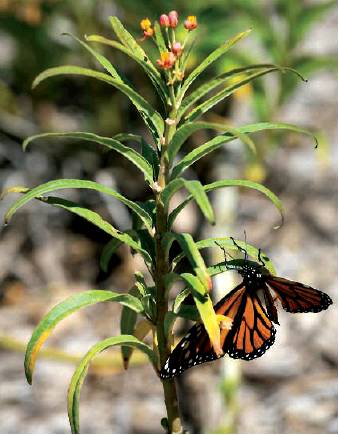BARRIER FOR BIRDERS
Border wall worries nature tourists, businesses
By Aaron Nelsen RIO GRANDE VALLEY BUREAU
HARLINGEN — Paul Lombardi and Daniel Johnston flocked to the Rio Grande Valley to see birds — green jays and black-tailed gnatcatchers, pied-billed grebes and tropical parulas, to name a few.
The group of wildlife refuges along the meandering Rio Grande attracts hundreds of thousands of visitors, searching for species found nowhere else in the country.
Even as exotic birds continue to captivate visitors, these days, conversation often turns to President Donald Trump and the specter of his “big, beautiful” wall looming over the native habitat that remains here.
“It’s a shame,” said Lombardi, a spry 76-year-old from the Salt Lake City area. “They can pretend that somehow all the animals are going to get around the wall, but they’re not.”
The 54 miles of existing border wall and bollard fencing already cut through parts of the Lower Rio Grande Valley National Wildlife Refuge wildlife corridor, but Trump’s wall imperils several additional tracts, including the iconic Santa Ana National Wildlife Refuge, considered the crown jewel of the refuge system.
Earlier this month, organizers for two of the Valley’s biggest annual events — the Texas Butterfly Festival and the Rio Grande Valley Birding Festival — did their best to focus on wildlife, but for many festival-goers the border wall poses an existential threat to a cherished pastime.
“I saw the rusty-brown wall today, and it was not a pleasant sight.”
Daniel Johnston, bird-watcher
“I saw the rusty-brown wall today, and it was not a pleasant sight,” said Johnston, 69, a former elementary school teacher. “In the long run, I bet these festivals will start to slow down.”
That’s what worries the Valley’s tourism industry.
Big money
More than 165,000 nature tourists visit the region each year, infusing $463 million into the local economy and sustaining 6,600 jobs, according to a 2011 Texas A&M University study.
The birding festival, the second-biggest event for birdwatching in the country, brings in nearly $2 million alone. About 600 people from five countries and 43 states attended the five-day festival this year, officials said.
Creating the ecotourism industry has taken decades of hard work, fundraising and public-private cooperation.
Much of the original native habitat in the Valley was cleared for farming. But in 1979, work began to create a wildlife corridor along the river from Falcon Dam to the Gulf of Mexico. Over the years, private landowners have sold parcels that community organizations, together with state and federal wildlife agencies, have carefully restored as habitat.
Army Corps of Engineers maps show plans for 28 miles of new levee wall and 32 miles of new border wall in the Valley, slicing through the wildlife corridor. Congress has approved $341 million to repair and strengthen existing fence, far short of the $1.6 billion the Trump administration has requested, but it’s enough to worry wildlife advocates.
In addition to nearly 3 miles of levee wall and fence through Santa Ana, the expected path of the fence would cut through or build around the 100-acre National Butterfly Center preserve; Bentsen-Rio Grande Valley State Park, a 797-acre preserve; and the Roma Bluffs World Birding Center.
Santa Ana is slated to receive an 18-foot steel bollard fence atop a concrete-base levee wall. The project would also clear a 150-foot “enforcement zone” adjacent to the fence, all of which would cost an expected $45 million, Corps of Engineers records show.
“We don’t take positions on politicians,” said Jeffrey Gordon, president of the American Birding Association. “Having said that, it’s clear that this proposed new wall is a disaster from a birder standpoint in terms of damage to habitat, in terms of loss of habitat.”
Blow to tourism
Over the past 20 years, Keith Hackland’s livelihood has depended on birders. All 20 rooms of the Alamo Inn B&B, Gear & Tours, where Hackland is innkeeper, fill to capacity during the butterfly and birding festivals. This year, everyone was talking about Trump’s wall, Hackland said.
“Two things will happen when it’s built: It will change the aesthetics of the place,” Hackland said of the wall. “The other is that people will hear the place has been destroyed, which may or may not be true, but it will reduce tourism and affect the income of everyone in the Valley, including me.”
Fear of the unknown may already be taking a toll on ecotourism in the Valley.
About 70 people showed up for the butterfly festival in Mission, generating $500,000 over four days. The buzz around this year’s festival was the sighting of an orange banner, Temenis laothoe, a species typically found anywhere from Mexico to Bolivia, not Texas.
Still, the turnout was less than half the more than 150 people who attended the festival last year. The butterfly center plans to sue the government to stop construction of the wall through its property.
“I do think it has to do with the border wall,” said Marianna Treviño Wright, executive director of the National Butterfly Center, a privately owned sanctuary. “We might not be able to prevent the wall from going up, but hopefully we can prevent a wholesale destruction of the hospitality and tourism industry.”
About a decade ago, when the first sections of border fence broke ground under the 2006 Secure Fence Act, 18-foot bollard fencing marooned birding sites between the rust-colored barrier and the Rio Grande.
One popular destination, the Old Hidalgo Pumphouse and World Birding Center, has not been the same since. A large swath of the birding center’s trails ended up south of the fence and are virtually inaccessible, despite assurances to preserve the refuge for public use, according to Sue Griffin, the birding festival chair.
“As far as my being able to take people on an extended visit of that area and able to see all of the birds possible, I can no longer do that, I have to find alternative places for my participants to go,” Griffin said. “When that wall goes in at Santa Ana, I don’t think anybody knows what will happen, but we’re hoping it will have some kind of a gate that gives people access to the other side.”
Investment at risk
Since 1934, when President Franklin D. Roosevelt signed the Duck Stamp Act, the conservation program has funneled around $800 million toward the Migratory Bird Conservation Fund.
A little more than 1,980 acres of the 2,088-acre Santa Ana refuge were purchased through the duck stamp program. The refuge, established in 1943, is home to at least 400 bird species and 300 butterfly species. And yet, advocates note, the Homeland Security Department can brush aside environmental laws to expedite building the wall.
“So much money has been invested in these places, and so much money is derived from them,” said Barbara Volkle, a Massachusetts resident who has been coming to South Texas since the 1980s. “People come to birding because they want to relax. If people feel like they aren’t welcome, they’ll spend their money somewhere else.”
Tiffany Kersten, a member of the Friends of the Wildlife Corridor, moved to the Valley several years ago to work at Santa Ana. While she no longer works at the refuge, Kersten enjoys birding there and guiding others.
She worked as a guide during two days of the birding festival. A sudden change of plans one day prompted her to give visitors the option of where they wanted to bird.
“I suggested Santa Ana,” Kersten recalled, “and they said, ‘That’s that place that we may never have access to again.’ ” anelsen@express-news.net | Twitter: @amnelsen



